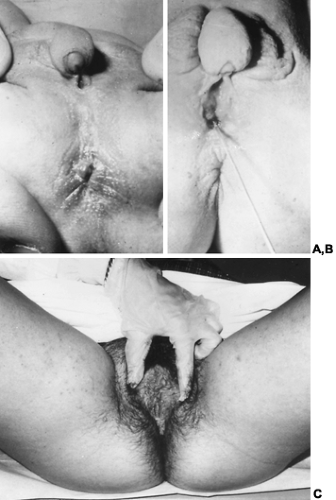CLINICAL APPROACH TO THE INFANT WITH GENITAL AMBIGUITY
IMMEDIATE CONCERNS AND DIAGNOSTIC TESTS
Infants with genital ambiguity (Fig. 90-26) must be evaluated promptly and the correct diagnosis determined to prevent life-threatening complications and to assuage the concerns of the parents. Immediate management requires attention to medical and psychological factors. If a competent group of gynecologists, urologists, pediatricians, psychiatrists, geneticists, and endocrinologists is not available, the patient is best referred to a medical center having such a team.
Cytogenetic and endocrine studies should be initiated. To determine the genetic sex, the physician should rely on lymphocyte cultures and not solely on analysis of buccal epithelial cells (i.e., buccal smear) for the presence or absence of X-chromatin or Y-chromatin. Use of a chromosome-specific probe for the Y chromosome can provide a rapid diagnosis (fluorescent in situ hybridization) of interphase nuclei. A complete karyotype of chromosomes from peripheral leukocytes arrested in metaphase is now available within 48 hours. The X and Y chromosomes can be examined by high-resolution banding for deletions, rearrangements, nondisjunction, and other defects. The X and Y chromosomes can also be characterized by in situ hybridization using X chromosome–specific probes or Y chromosome–specific probes.
Increasingly, even more sophisticated genetic techniques are being used to identify specific gene defects in intersex disorders. Several genes important in sexual differentiation, including SRY and the genes for the androgen receptor, 5α-reductase, 21-hydroxylase, and antimüllerian hormone and its putative receptor, have all been cloned and are available as probes. Genomic DNA obtained from peripheral leukocytes and mRNA or complementary DNA from gonadal or genital skin biopsies can be used for these studies. Gene conversions, deletions, and insertions can be identified by northern and southern analysis. Restriction fragment length and other dinucleotide repeat polymorphisms have proved to be especially useful for studying segregation of 21-hydroxylase genes. DNA sequencing and polymerase chain reaction techniques can be used to detect single base mutations and microconversions in the genes that have been isolated. DNA diagnostic tests have proven disappointing in sporadic cases because of molecular heterogeneity. Once the molecular basis is known for an index case, however, a molecular basis exists for identifying other affected family members.
Stay updated, free articles. Join our Telegram channel

Full access? Get Clinical Tree






